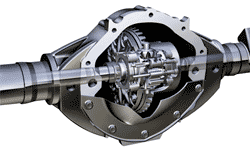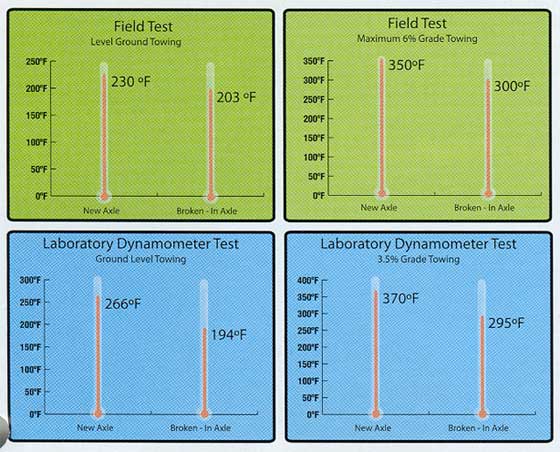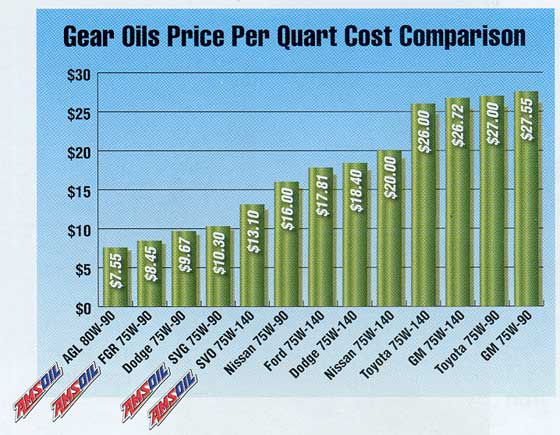|
Change Gear Lube After Break-In Period For Long
Differential Life
Motorists know when they’re supposed to change their
motor oil. They have owners manuals, oil life monitors,
oil change centers and commercials all telling them when
it’s time for an oil change. Differential oil changes,
on the other hand, often get overlooked. Many people
don’t even think of the differential when performing
routine maintenance on their vehicles and don’t realize
four-wheel drive trucks have two differentials and a
transfer case that all require service. In fact,
according to one quick lube company, only one to two
percent of their customers purchase a differential gear
lube change.
 Differential
internal components consist of six gears (one pinion, one ring, two
side and two spider gears), six bearings (two pinion, two carrier
and two axle) and sometimes include a clutch setup for limited slip
performance. All of these parts require high quality, clean gear oil
in order to perform at an optimal level. Differential
internal components consist of six gears (one pinion, one ring, two
side and two spider gears), six bearings (two pinion, two carrier
and two axle) and sometimes include a clutch setup for limited slip
performance. All of these parts require high quality, clean gear oil
in order to perform at an optimal level.
Most pickup trucks, SUVs and vans operate in severe service
conditions, including towing, hauling, steep hill driving,
commercial use, plowing, racing, off-road use, rapid acceleration,
frequent stop-and-go operation and high ambient temperatures. These
severe service operating conditions subject the differential to
extreme pressures and operating temperatures.
New vehicles such as turbo diesel trucks and vehicles with V-10
engines boast more horsepower and torque than their predecessors,
but differential designs have remained virtually unchanged.
Differentials today are subjected to severe duty service and
encounter more stress and heat than was seen only a few years ago.
Modern gear oils are faced with the challenge of providing adequate
wear protection during severe service operating conditions, while
also providing maximum fuel efficiency.
In fact, according to a 2005 SAE paper entitled Breaking the
Viscosity Paradigm: Formulating Approaches for Optimizing Efficiency
and Vehicle Life, “Concurrent with the strong drive toward better
fuel economy, consumers have been demanding increased performance,
which has required axle lubricants with enhanced durability
protection and lower operating temperatures. There has been a 34%
increase in engine horsepower over the last decade, while axle gear
sizes have remained constant, sump capacities have been lowered, and
drain intervals extended. In the light truck segment there has been
a 93% horsepower increase since 1981.”
Most differential wear occurs during the break-in period. Because
differentials are not equipped with filters, break-in metals are
suspended in the oil, causing increased wear as the particles mesh
between the gears. Hauling heavy loads and towing heavy trailers
cause additional stress to the differential during the break-in
period and can cause premature differential damage. Changing the
gear lube after the break-in period (about 5,000 miles) greatly
reduces wear and extends differential gear and bearing life. Auto
manufacturers are beginning to recognize the importance of draining
abrasive break-in materials. As seen in the chart, some
manufacturers recommend an initial drain interval of between 500 and
3,000 miles.
Further evidence of stress and increased temperatures during the
differential break-in period is documented in a 2005 SAE paper
entitled The Effect of Heavy Loads on Light Duty Vehicle Axle
Operating Temperature. A light duty GM truck towing 14,000 pounds
was driven from Orange County, Calif. to the Nevada state line. The
test was conducted with both a new axle and a broken-in axle. Over
level ground towing, oil temperature was measured at 110 degrees F
in the new axle and 95 degrees F in the broken-in axle. Oil
temperature over the most grueling portion of the trip, during which
a maximum 6% grade was encountered, revealed the new axle was
operating at 350 degrees F and the broken-in axle was operating at
300 degrees F. Laboratory dynamometer test results simulating a
truck hauling a trailer provided similar results, with level ground
towing temperatures recorded at 266 degrees F with the new axle and
194 degrees F with the broken-in axle and towing temperatures (at a
3.5% grade) recorded at 370 degrees F with the new axle and 295
degrees F with the broken-in axle.
AMSOIL SEVERE GEAR™ 75W-90,
75W-110, and
75W-140 Synthetic Gear Lubes are
formulated for severe service applications, protecting differential
gears for extended drain intervals of up to 50,000 miles in severe
service and 100,000 miles in normal service, or longer where
specified by the vehicle manufacturer. Formulated with shear stable
synthetic base stocks and an extra treatment of additives, SEVERE
GEAR™ Gear Lubes provide unsurpassed wear protection and friction
reduction, while their excellent thermal stability prevents thermal
runaway, a phenomenon caused by a lubricant’s inability to control
friction and increased heat under high stress conditions.
AMSOIL SEVERE GEAR™ Synthetic Gear Lubes are recommended for
turbo diesel pick-ups, SUVs, vans, delivery/utility vehicles, light,
medium and heavy-duty trucks, buses, heavy equipment, 4x4s, tow
trucks, race cars, tractors and motor homes.


|

